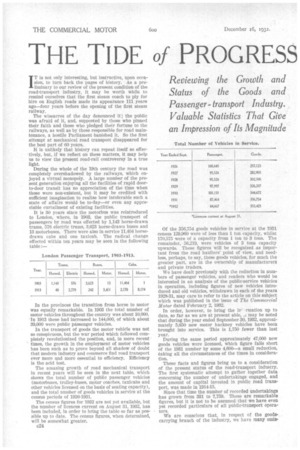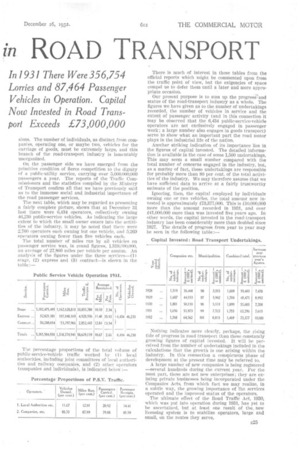THE TIDE
Page 70

Page 71

If you've noticed an error in this article please click here to report it so we can fix it.
of PROGRESS in ROAD TRANSPORT
Reviewing the Growth and Status of the Goods and Passenger,transport Industry.
Valuable Statistics That Give an Impression of Its Magnitude In 1931 There Were 356,754 Lorries and 87,464 Passenger Vehicles in Operation. Capital Now Invested in Road Trans port Exceeds £73,000,000
IT is not only interesting, but instructive, upon occasion, to turn back the pages of history. As a preliminary to our review of the present condition of the road-transport industry, it may be worth while to remind ourselves that the first steam coach to ply for hire on English roads made its appearance 111 years ago—four years before the opening of the first steam railway.
The wiseacres of the day denounced it; the public was afraid of it, and, supported by those who pinned their faith and those who pledged their fortune to the railways, as well as by those responsible for road maintenance, a hostile Parliament banished it. So the first attempt at mechanical road transport disappeared for the _best part of 60 years.
It is unlikely that history can repeat itself so effectively, but, if we reflect on these matters, it may help us to view the present road-rail controversy in a true light.
During the whole of the 19th century the road was completely overshadowed by the railways, which enjoyed a virtual monopoly. A large number of the present generation enjoying all the facilities of rapid doorto-door transit has no appreciation of the time when these were non-existent, but it may be credited with sufficient imagination to realize how intolerable such a state of affairs would be to-day—or even any appreciable curtailment of existing facilities.
It is 30 years since the motorbus was reintroduced to London, where, in 1903, the public transport of passengers by road was effected by 1,143 horse-drawn trams, 576 electric trams, 3,623 horse-drawn buses and 13 motorbuses. There were also in service 11,404 horsedrawn cabs and one taxicab. The radical change effected within ten years may be seen in the following table :
In the provinces the transition from horse to motor was equally remarkable. In 1903 the total number of motor vehicles throughout the country was about 10,000. -In 1913 these had increased to 144,000, of which about 39,000 were public passenger vehicles.
In the transport of goods the motor vehicle was not so conspicuous, but the war period which followed completely revolutionized the position, and, in more recent times, the growth in the employment of motor vehicles has been such as to prove beyond all shadow of doubt that modern industry and commerce find road transport ever more and more essential to efficiency. Efficiency is the acid test.
The amazing growth of road mechanical transport in recent years will be seen in the next table, which shows the total number of public passenger vehicles (motorbuses, trolley-buses, motor coaches, taxicabs and other vehicles licensed on the basis of seating capacity), and the total number of goods vehicles in service at the census periods of 1926-1931.
The census figures for 1932 are not yet available, but the number of licences current on August 31, 1932, has been included, in order to bring the table so far as possible up to date. The census figures, when determined, will be somewhat greater.
024 Of the 356,754 goods vehicles in service at the 1931 census 129,960 were of less than 1 ton capacity, whilst 170,575 were of a capacity from 1 ton to 3 tons. The remainder, 56,219, were vehicles of 3 tons capacity upwards. These figures will be recognized as important from the road hauliers' point of view, and needless, perhaps, to say, these goods vehicles, for much the greater part, are in the ownership of manufacturers and private traders.
We have dealt previously with the reduction in numbers of passenger vehicles, and readers who would be interested in an analysis of the public-service vehicles in operation, including figures of new vehicles introduced and old vehicles, withdrawn in each of the years 1928-31, may care to refer to the article on this subject which was published in the issue of The Commercial Motor dated February 2, 1932.
In order, however, to bring the in rmation up to date, so far as we are at present able, may be noted that during the year ended September 30, 1932, approximately 5,650 new motor hackney vehicles have been 'brought into service. This is 1,750 fewer than last year.
During the same period approximately 47,000 new goods vehicles were licensed, which figure falls short of the 1931 number by some 4,600—a small reduction, taking all the circumstances of the times in consideration.
These facts and figures bring us to a consideration of the present status of the road-transport industry. The first systematic attempt to gather together data concerning the number of undertakings engaged, and the amount of capital invested in public road transport, was made in 1914-15. Since that time the number of recorded undertakings has grown from 331 to 7,759. These are remarkable .figures, but it is not to be assumed that we have even yet recorded particulars of all public-transport operators.
Vire are conscious that, in respect of the goodscarrying branch of the industry, we have many omis
sions. The number of individuals, as distinct from companies, operating one, or maybe two, vehicles for the carriage of goods, must be extremely large, and this branch of the road-transport industry is lamentably unorganized.
On the passenger side we have emerged from the primitive condition of fierce competition to the dignity of a public-utility service, carrying Over 5,000,000,000 passengers a year. The reports of the Traffic Commissioners and the statistics compiled by the Ministry of Transport confirm all that we have previously said as to the immense social and industrial importance of the road passenger services.
The next table, which may be regarded as presenting a fairly complete picture, shows that at December 31 last there were 6,434 operators, collectively owning 46,230 public-service vehicles. As indicating the large extent to which the small owner enters into the activities of the industry, it may qe noted that there were 2,760 operators each owning but one vehicle, and 5,269 operators owning fewer than five vehicles each.
The total number of miles run by all vehicles on passenger service was, in round figures, 1,319,000,000, an average of 27,800 miles per vehicle per annum. An analysis of the figures under the three services-(1) stage, (2) express and (3) contract-is shown in the table : The percentage proportions of the total volume of public-service-"vehiele traffic worked by (1) local authorities, including joint committees of local authorities and railway companies, and (2) other operators (companies and individuals), is indicated below:
There is much of interest in these tables from the official reports which might be commented upon from the traffic point of view, but the exigencies of space compel us to defer them until a later and more appropriate occasion.
Our present purpose is to sum up the progress and status of the road-transport industry as a whole. The figures we have given as to the number of undertakings recorded, the number of vehicles in service and the extent of passenger activity (and in this connection it may be observed that the 6,434 public-service-vehicle operators are not exclusively engaged in passenger work; a large number also engages in goods transport) serve to showwhat an important part the road motor plays in the industrial life of the nation.
Another striking indication of its importance lies in the figures of capital invested. The detailed information is available in the case of some 1,500 undertakings. This may seem a sm-all number compared with the total number of concerns engaged in the industry, but, as a matter of fact, these undertakings are responsible for probably more than 80 per cent. of the total activities of the industry. We may therefore assume that we have sufficient data to arrive at a fairly trustworthy estimate of the position.
Ignoring, then, the capital employed by individuals owning 0110 or two vehicles, the total amount now invested is approximately £73,377,000. This is £10,000,000 more than the amount recorded in 1931, and over £41,000,000 more than was invested five years ago. In other words, the capital invested in the road-transport industry has been considerably more than doubled since 1927. The details of progress from year to year may be seen in the following table: Capital Invested: Road Transport Undertakings.
Nothing indicates more clearly, perhaps, the rising tide of progress in road transport than these constantly growing figures of capital invested. It will be perceived from the number of undertakings included in the calculations that the growth is one arising within the industry. In this connection a conspicuous phase of development at the present time may be referred to.
A large number of new companies is being registered -several hundreds during the current year. For the most part, these are not new enterprises; they are existing private businesses being incorporated under the Companies Acts, from .which fact we may realize, in a subtle way, the growing importance of the services operated and the improved status of the operators.
The ultimate effect of the Road Traffic Act, 1930, which was put into operation during 1931, has yet to be ascertained, but at least one result of the.:, new licensing system is to stabilize operators, large and small, on the routes they serve.




























































































































































